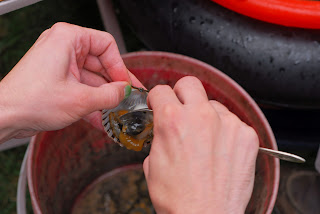My Refrigerator uses a control board to run everything and I started having problems with the ice dispenser and light not working reliably, before eventually failing to work all together.
I noticed that the two above capacitors were starting to bulge out the top, the easiest indication of a failure.
The tops of these should be completely flat. These had bowed out visibly and started to open up slightly in the center. Replacing these fixed all of my issues.
This is usually a sign that the capacitor should be replaced.
The new capacitor in place, note the shiny end cap.
Theres a few reasons that capacitors tend to be the failure point. They're an expensive, bulky, yet vital component in modern electronics so often tradeoffs need to be made. A smaller capacitor can fit in a more cramped housing, but won't last as long, larger capacitors tend to be more expensive, and a device may be simply be poorly designed for its operating environment. Overheating is what typically causes capacitors to fail, but usually this is due to one of the previous reasons letting it overheat in the first place. There have also been incidents when cheap manufacturers have used stolen copies of stolen copies of electrolyte recipes resulting in capacitors that did not meet the proper spec. A batch of these bad capacitors made in the early 2000's found their way into all sorts of electronics, and Dell had an issue with a nearly 100% failure rate with one of their lines of desktop computer within one year, all due to using cheap capacitors.
Diagnostics
Typically if an electronic device stops working suddenly, the issue can be traced to a bad capacitor. You can see the brown one on the left is bowed out on the top a little, and is smaller than the same spec cap from a known quality electronics manufacturer. Other symptoms include powering on for short periods of time, random device resets, squealing sounds coming from the device, etc.
Sometimes a capacitor will start to leak, and the electrolyte will corrode nearby components
Repair
Once you've identified that a capacitor is bad (or if you want to try replacing the caps before tossing the device in the junk heap, you need to get replacement capacitors. Radio Shack still sells a few sizes but for the most part you'll need to order online from a catalog like Mouser (no minimum order, just shipping costs) or Digikey (minimum order size of around $20, plus shipping) The 2 numbers you need to match are the voltage and the capacitance (in this example, I'm replacing some 16V, 2200uf and 200V, 47uf. These are usually marked on the side of the capacitor. If you can't find an exact match, you can safely use a larger size for both values, but keep in mind that this usually makes for a physically larger capacitor as well, so the closer the match, the easier the replacement will be. For a large run capacitor like on an AC unit, make sure to use a compatible part as these are often multiple capacitors in one can. I looked up the model number for my AC unit and searched on Amazon for a compatible part number.
Tools and Skills
You should have some experience with soldering to continue. I use a 30w soldering iron, this job is much easier if you use a good iron or soldering station.
The other tools you will need are:
Soldering Iron
Solder extractor or desoldering braid
Solder
Offset/Diagonal cutters
If the board is not clearly marked, note which side the negative (-) side of the capacitor is facing. The lighter stripe and - sign indicate the negative side. This board is also clearly marked for each component.
I remove the old capacitor from the board by heating the solder around its terminals and using the solder extractor to suck the melted metal from around the contact. The extractor has a spring loaded piston which is released by pressing a button, creating a strong suction.
The old capacitor can now be pulled free, note the clearly marked + side of the board. The longer lead on the new capacitor is the positive (+) and the shorter the negative. This is also marked on the side of the capacitor as noted previously.
I bend the leads outwards to hold the capacitor in place while I flip the board upside down to solder.
The solder should flow cleanly around the lead and board
 |
And the excess leads are cut away.



































